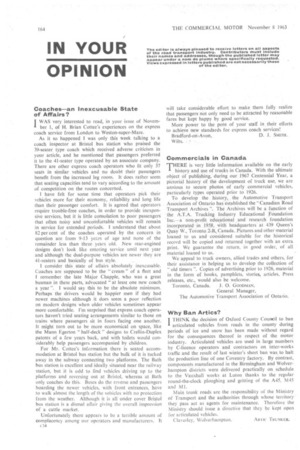IN YOUR OPINION
Page 166

If you've noticed an error in this article please click here to report it so we can fix it.
Coaches—an Inexcusable State of Affairs?
I WAS very interested to read, in your issue of November 1, of H. Brian Cottee's experiences on the express coach service from London to Weston-super-Mare.
As it so happened I was only this week talking to a coach inspector at Bristol bus station who praised the 39-seater type coach which received adverse criticism in your article, and he mentioned that passengers preferred it to the 41-seater type operated by an associate company. There are other express coach operators who fit only 37 seats in similar vehicles and no doubt their passengers benefit from the increased leg room. It does rather seem that seating capacities tend to vary aicording to the amount of competition on the routes concerned.
I have felt for some time that operators pick their vehicles more for their economy, reliability and long life than their passenger comfort. It is agreed that operators require trouble-free coaches, in order to provide inexpensive services, but it is little consolation to poor passengers that often noisy and uncomfortable vehicles will remain in service for extended periods. I understand that about 82 per cent of the coaches operated by the concern in question are from 9-13 years of age and none of the remainder less than three years .old. New rear-engined designs don't look like entering service until next year and although the dual-purpose vehicles are newer they are 41-seaters and basically of bus style.
I consider this state of affairs absolutely inexcusable. Coaches are supposed to be the cream" of a fleet and I remember the late Major Chapple, who was a great busman in these parts, advocated "at least one new coach a year ". I would say this to be the absolute minimum. Perhaps the drivers would be happier men if they had newer machines although it does seem a poor reflection on modern designs when older vehicles sometimes appear more comfortable. I'm surprised that express coach operators haven't tried seating arrangements similar to those on trains where passengers sit in fours facing one another. It might turn out to be more economical on space, like the Mann Egerton " half-deck " designs to Crellin-Duplex patents of a few years back, and with toilets would considerably help passengers accompanied by children.
For Mr. Cottee's information there is seated accommodation at Bristol bus station but the bulk of it is tucked away in the subway connecting two platforms. The Bath bus station is excellent and ideally situated near the railway station, but it is odd to find vehicles driving up to the platforms and reversing out at Bristol, whereas at Bath only coaches do this. Buses do the reverse and passengers boarding the newer vehicles, with front entrances, have to walk almost the length of the vehicles with no protection from the weather. Although it is all under cover Bristol bus station is a dismal affair giving the overall impression of a cattle market.
Unfortunately there appears to be a terrible amount of complacency among our operators and manufacturers. It c34 will take considerable effort to make them fully realize that passengers not only need to be attracted by reasonable fares but kept happy by good service.
More power to the pens of your staff in their efforts to achieve new standards for express coach services!
Bradford-on-Avon, D. J. SMITH. Wilts.
Commercials in Canada THERE is very little information available on the early history arid use of trucks in Canada. With the ultimate object of publishing, during our 1967 Centennial Year, a pictorial history of the development of truck use, we are anxious to secure photos of early commercial vehicles, particularly types operated prior to 1926.
To develop the history, the Automotive Transport Association of Ontario has established the "Canadian Road Transport Archives ". The Archives will be a function of the A.T.A. Trucking Industry Educational Foundation inc.—a non-profit educational .and research foundation incorporated in 1958, with headquarters at 439 Queen's Quay W., Toronto 2-B, Canada. Pictures and other material loaned to us and considered suitable for the historical record will be copied and returned together with an extra print. We guarantee the return, in good order, of all material loaned to us.
We appeal to truck owners, allied trades and others, for their assistance in helping us to develop the collection of "old timers ". Copies of advertising prior to 1926, material in the form of books, pamphlets, stories, articles, Press releases, etc., would also be welcome.
Toronto, Canada. J. 0. GOODMAN, General Manager, The Automotive Transport Association of Ontario.
Why Ban Artics?
I THINK the decision of Oxford County Council to ban I articulated vehicles from roads in the county during periods of ice and snow has been made without regard for the consequences thereof in respect of the motor industry. Articulated vehicles are used in large numbers by C-licence operators and contractors on inter-works traffic and the result of last winter's short ban was to halt the production line of one Coventry factory. By contrast, components manufactured in the Birmingham and Wolverhampton districts were delivered practically on schedule to the Vauxhall works at Luton thanks to the regular round-the-clock ploughing and gritting of the A45, M45
and MI. • Main trunk roads are the responsibility of the Ministry of Transport and the authorities through whose territory they pass act as agents for maintenance. Therefore the Ministry should issue a directive that they be kept open for articulated vehicles.
Claverley, Wolverhampton. A RIK' TRUNK ER.














































































































































































































































